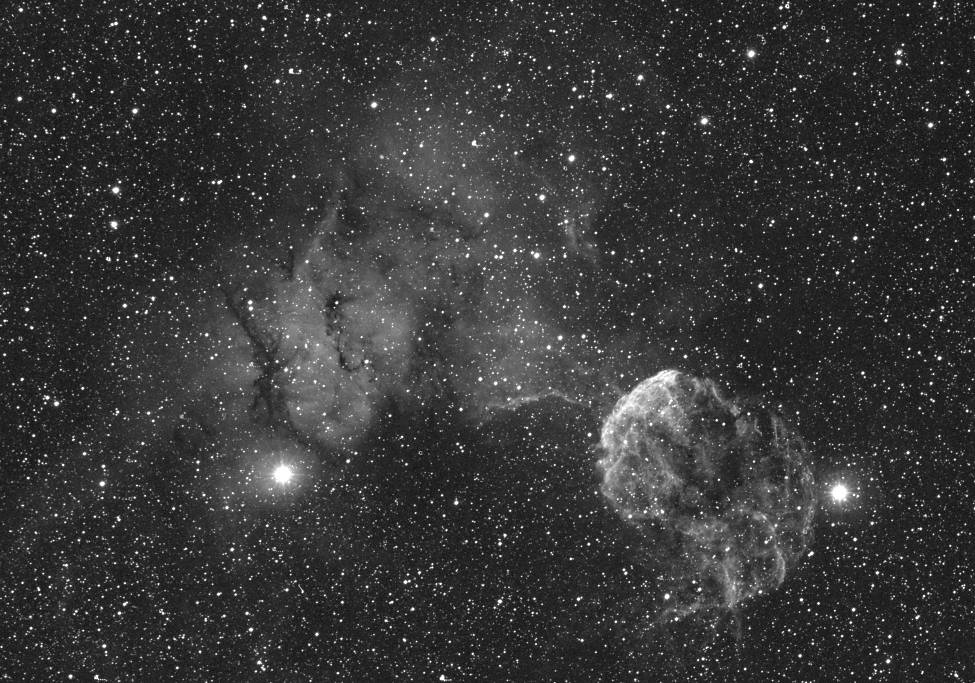5h exposure (Ha:30x600s)
Acquired from the 30th to the 31st of December 2019 with Samyang 135mm
From 09:56 pm to 04:22 am GMT+1

Setup: Samyang 135mm F/2, AZ-EQ6, QHY163m gain=100, QHYCFW2-M, AstroLink 4 mini, QHY5L2M. Software: APT, Stellarium scope, EQ MOD, PHD2
This image has mainly been acquired for future HOO/SHO mix. But the region is also located on the ecliptic plan giving some interest for looking at possible solar system objects. Let’s see if the Ha filter may have some influence on the detectivity of possible asteroids…
Location
The field of view of this image lies west of Gemini constellation at proximity of the northern part of Orion. This is an interesting place in the Milky Way containing several bright deep sky objects.
Deep sky objects
Main deep sky objects are quickly mentioned below. A longer description will come on a future HOO or SHO post.
M35 and NGC2158 are bright and very nice open clusters located respectively at 3800 and 11000ly from earth. In the same scale of distance – 5000ly from us – lies IC443/SH2-248 also named the Jellyfish nebula. This is a supernova remnant with an age estimated between 3000 and 30000 years old.
On the east of IC443 lies SH2-249, a large HII region partially hidden by several dark nebulas. SH2-249 contains also reflection nebula identifed as IC444 which is of course not visible on this Ha image.
More on the south west is located Sh2-252 named the Monkey Head nebula. This bright HII region is at about 6500ly from earth.
Annotation of these objects figure on the image below.
The area of this image is also on the solar system plan, so crossed by moon and planets, but also by smaller objects: the asteroids.
Asteroids
Asteroids detection is revealed using preprocessing with image integration in maximum mode. This mode preserves all the transient details of each images of the stack and thus the movement of asteroids. Their detectection is helped in case of meridian flip: trajectories are brifly interupted!
Here is below image crops showing the trajectory of several asteroids. Crops are ordered clockwise starting top left of the full image. Annotation is executed under Pixinsight by loading data extracted from Aladin/Skybot.
Yatsuka is surprisingly not detected above whereas its magnitude is similar to others asteroids visible on this image. Concern with asteroid database? or simply related to the usage of Ha filter?
Video animation of Dresda asteroid
Here is below a video showing the Dresda asteroid movement over the period of acquisition. Zellner is also slighly visible on this video. Others moving “objects” are camera artifacts combined with dithering effect.
Asteroids characteristics
For curiosity, here is a summary of every asteroids identified on this image.
Name: Asteroid name (if exist) or ateroid reference
V: Apparent magnitude at the date of shooting (28th of February 2019)
Dia: Asteroid diameter in km
OP: Orbital Period in year
OR: Orbital radius in astronomical unit (1au = average sun-earth distance)
Classification: Group or family of asteroids
Dis: Discovery date
| Name | V | Dia (km) | OP (y) | OR (ua) | Classification | Dis |
|---|---|---|---|---|---|---|
| Dresda | 14 | 23.2 | 4.9 | 2.88 | MB>Outer | 1886 |
| Volga | 14.3 | 55.57 | 4.94 | 2.9 | MB>Outer | 1929 |
| David Hughes | 14.7 | 31.22 | 2.27 | 1.73 | Mars-Crosser | 1985 |
| 1989 UU1 | 14.8 | 6.47 | 3.31 | 2.21 | MB>Inner | 1989 |
| Algunde | 14.8 | 11.44 | 3.35 | 2.23 | MB>Inner | 1920 |
| Aesculapia | 14.9 | 31.22 | 5.6 | 3.15 | MB>Outer | 1923 |
| Amalasuntha | 14.9 | 18.6 | 3.85 | 2.46 | MB>Inner | 1907 |
| Wallenbergia | 15.1 | 8.03 | 3.25 | 2.19 | MB>Inner | 1924 |
| Yatsuka | 15.5 | 4.74 | 3.67 | 2.38 | MB>Inner | 1993 |
| Zellner | 15.7 | 8.05 | 3.32 | 2.23 | MB>Inner | 1981 |
| Leningrad | 15.9 | 23.96 | 5.64 | 3.17 | MB>Outer | 1968 |
| Rubtsov | 15.9 | 10.14 | 4.99 | 2.92 | MB>Outer | 1988 |
| Podobed | 16 | 17.33 | 4.66 | 2.79 | MB>Middle | 1976 |
Asteroid orbit
Among the above asteroids, David Hughes stands out from the crowd. This is a Mars Crosser meaning its orbit crosses the planet orbit. Per chance, this occured only few days before the image capture date! But Mars was far away at this time…
Conclusion
This image is acquired on an area of the ecliptic plan with possibly some solar system objects like asteroids. Despite the destination of the image (HOO/SHO mix) and the usage of Ha filter, it has been possible to detect more than ten of them!
According to this post and a previous one about asteroids in Virgo cluster, I will keep in mind the following detectivities for my Samyang 135mm setup (at F/2.8):
- Up to magnitude 16 for unitary exposure of 600s in Ha 6nm narrow band
- Up to magnitude 18.5 for unitary exposure of 300s in L band










